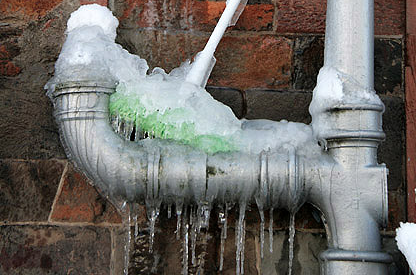Protecting Against Frozen Pipes in Cold Weather: Pro Tips
Protecting Against Frozen Pipes in Cold Weather: Pro Tips
Blog Article
What're your insights and beliefs on Helpful Tips to Prevent Frozen Pipes this Winter?
:strip_icc()/snow-outdoor-faucet-pipes-4af65d1e5e904fb1aa7bf74071fe5d89.jpg)
Winter can wreak havoc on your pipes, especially by freezing pipes. Below's just how to avoid it from taking place and what to do if it does.
Introduction
As temperatures decline, the risk of frozen pipelines boosts, possibly resulting in pricey repair work and water damages. Recognizing exactly how to avoid frozen pipes is critical for property owners in cold climates.
Understanding Icy Pipes
What causes pipes to freeze?
Pipelines freeze when subjected to temperature levels below 32 ° F (0 ° C) for extended durations. As water inside the pipelines freezes, it expands, putting pressure on the pipeline wall surfaces and potentially causing them to rupture.
Dangers and damages
Icy pipelines can lead to supply of water disturbances, property damages, and costly repair services. Burst pipelines can flood homes and trigger considerable architectural damage.
Indications of Frozen Pipes
Determining icy pipes early can avoid them from bursting.
Just how to recognize frozen pipes
Seek reduced water circulation from faucets, unusual smells or sounds from pipelines, and visible frost on revealed pipes.
Prevention Tips
Shielding vulnerable pipes
Wrap pipelines in insulation sleeves or make use of warm tape to protect them from freezing temperatures. Focus on pipes in unheated or external locations of the home.
Home heating methods
Maintain interior areas appropriately warmed, specifically locations with pipes. Open cupboard doors to allow cozy air to flow around pipelines under sinks.
Safeguarding Outdoor Pipes
Garden hose pipes and outdoor faucets
Separate and drain yard hose pipes before winter months. Install frost-proof faucets or cover outdoor faucets with insulated caps.
What to Do If Your Pipelines Freeze
Immediate actions to take
If you believe icy pipes, maintain taps available to alleviate stress as the ice thaws. Utilize a hairdryer or towels soaked in warm water to thaw pipes gradually.
Long-Term Solutions
Architectural modifications
Consider rerouting pipes far from outside wall surfaces or unheated locations. Add additional insulation to attic rooms, cellars, and crawl spaces.
Upgrading insulation
Purchase high-quality insulation for pipes, attics, and walls. Proper insulation assists keep consistent temperatures and minimizes the threat of icy pipelines.
Verdict
Avoiding frozen pipes requires proactive actions and fast actions. By comprehending the causes, indicators, and safety nets, property owners can protect their plumbing during cold weather.
6 Proven Ways to Prevent Frozen Pipes and Protect Your Home
Disconnect and Drain Garden Hoses
Before winter arrives, start by disconnecting your garden hoses and draining any remaining water. Close the shut-off valves that supply outdoor hose bibs and leave the outdoor faucet open to allow any residual water to drain. For extra protection, consider using faucet covers throughout the colder months. It’s also important to drain water from any sprinkler supply lines following the manufacturer’s directions.
Insulate Exposed Pipes
Insulating your pipes is an effective way to prevent freezing. Pipe insulation is readily available at home improvement stores and is relatively inexpensive. Pay close attention to pipes in unheated areas such as the attic, basement, crawl spaces, or garage. Apply foam insulation generously to create a buffer against the cold. You can also wrap your pipes in heat tape or thermostat-controlled heat cables for added warmth.
Seal Air Leaks
Inspect your home for any cracks or openings that could let in cold air. Seal any holes around the piping in interior or exterior walls, as well as the sill plates where your home rests on its foundation. Additionally, make sure to keep your garage door closed unless you’re entering or exiting. Leaving it open creates a significant air leak that can lead to frozen pipes.
Allow Warm Air Circulation
During cold snaps, it’s essential to allow warm air to circulate evenly throughout your home. Leave interior doors ajar to promote better airflow. Open kitchen and bathroom cabinets to help distribute heat consistently around the rooms. If you have small children or pets, be sure to remove any household chemicals or potentially harmful cleaners from open cabinets for safety.
Let Faucets Drip
A small trickle of water can make a big difference in preventing ice formation inside your pipes. When temperatures drop significantly, start a drip of water from all faucets served by exposed pipes. This continuous flow helps prevent the water from freezing. Additionally, running a few faucets slightly can relieve pressure inside the pipes, reducing the chances of a rupture if the water inside does freeze.
https://choateshvac.com/6-proven-ways-to-prevent-frozen-pipes-and-protect-your-home/

We hope you liked our part on Preventing and dealing with frozen pipes. Thanks a lot for taking a few minutes to read our piece. Remember to take the time to share this blog entry if you appreciated it. Many thanks for your time invested reading it.
Schedule Appointment Now Report this page